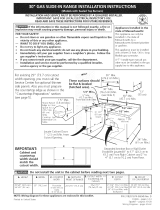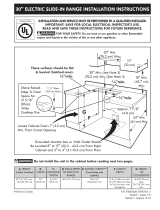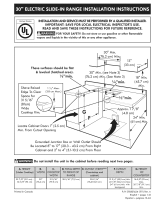
Notas importantes para el instalador
1. Lea todas las instrucciones contenidas en este manual
antes de instalar la estufa.
2. Saque todo el material usado en el embalaje del
compartimiento del horno antes de conectar el
suministro el_ctrico o de gas a la estufa.
3. Observe todos los c6digos y regiamentos pertinentes.
4. Deje estas instrucciones con el comprador.
5. Nota: Para la utilizaci6n a m6s de 2 000 pies de aitura,
la potencia del aparato deber6 ser reducida de 4 por
ciento a cada 1 000 pies adicionales.
Nora Importante para el Consumidor
Conserve estas instrucciones y el Manual del Usuario para
referencia futura.
IMPORTANTES INSTRUCCIONES
DE SEGURIDAD
Instalaci6n de esta estufa debe cumpiir con todos los
c6digos locales, o en ausencia de c6digos locales con
ei C6dicjo Nacionai de Gas Combustible ANSI Z223.1/
NFPA .54--0itima edici6n.
El dise_o de esta estufa ha sido certificado por ia CSA
Internacionai. En 8ste como en cuaiquier otto artefacto
que use gas y cjenere calor, hay ciertas precauciones de
secjuridad que usted debe seguir. Estas ser6n encontradas
en el Manual dei Usuario, iSalo cuidadosamente.
° AsegOrese de que la estufa sea instalada y conectada
a tierra en farina aproplada par un instalador
callficado o par un t_cnlco.
° Esta estufa debe ser el_ctrlcamente puesta a fierra de
acuerdo con los c6dlgos locales, o en su ausencla, con
el C6dlgo El_ctrlca Naclanal ANSi/NFPA No. 70, 01fima
edlci6n. Yea ias instrucciones para ia puesta a tierra.
° Antes de instalar la estufa en un 6rea cuyo plsa
este recublerto con lln61eo u afro tipo de plso
slnt_tlco, aseg_rese de que _stos puedan reslstlr
una temperatura de par Io menos 90°F sabre la
temperatura amblental sin provacar encoglmlenta,
defarmaci6n a decolaraci6n. No instale la estufa sobre
una alfombra al menos que coloque una piancha de
material aislante de por Io menos 1/4 pulcjada, entre
ia estufa y ia aifombra.
* Toclaslas estufas pueclen volcarse.
. Estopoclria resultar en lesiones personales.
" Instale el dispositivo anti vuelcos que se ha
empacaclo junto con esta estufa.
Para rectucir el riesgo de que se vuelque la
estufa, hay que asegurarla adecuaclamente
colo candole los soportes antivuelco que
se proporcionan. Para comprobar siestos
estan instalados y apretaclos en su lugar
como se clebe, ase el borcle trasero superior de la estufa y
cuidado samente incline la hacia aclelante para asegurar
que la estufa se ancle.
° Aseg0rese de que el material que recubre las
paredes alrededor de la estufa, pueda reslstlr el
calor generada par la estufa.
* No obstruya el flujo del alre de combusti6n en la
ventilaci6n del horno nl iampoco alrededor de la
base o debaja del panel inferior delantera de la
estufa. Evite tocar las aberturas o 6reas cercanas
de la ventilaci6n, ya que pueden estar muy calientes
durante el funcionamiento del horno. La estufa requiere
aire fresco para la combusti6n apropiada de los
quemadores.
II_ Nunca deje hi,as solos o desa|endldos
en un c_rea donde un artefacto estc_ slendo usado. A
medida que los ni_os crecen, ens_eles el uso apropiado
y de secjuridad para todos los artefactos. Nunca deje
la puerta del horno abierta cuando la estufa est6
desatendida.
No se pare, apoye o slen|e en las puertas
o calories de esta estufa pues puede resuffar en serlas
leslones y puede tambi_n causar da_a a la estufa.
° No almacene articulos que puedan interesar a los
nifios en los gablnetes sabre la estufa. Los ni_os
pueden quemarse seriamente tratando de trepar a la
estufa para alcanzar estos articulos.
" Los gablneies de almacenamlenio sabre la esiufa
deben set evltados, para ellmlnar la necesldad de
tener que pasar sabre los quemadores superlores de
la estufa para ffegar a elias.
* Ajuste el tama5a de la llama de los quemadares
superlores de tal manera que _sta no sobrepase el
horde de los utensillos de coclnar. La llama excesiva
es peligrosa.
° No use el homo coma espaclo de almacena_e. Esto
crear6 una situaci6n potencialmente peligrosa.
* Nunca use la estufa para caleniar el cuarto. El usa
proloncjado de la estufa sin la adecuada ventilaci6n
puede resultar pelicjroso.
* No almacene nl uHllce gasollna u arras vapores y
ffquldos inflamables en la proxlmldad de _ste o de
cualquler afro artefacto el_ctrlco. Puede provocar
incendio o expiosi6n.
° En caso de una interrupti6n del servicio el_ctrico, es
posible de encender los quemadores de superficie
a mano. Para encender un quemador de superficie,
acerque un f6sforo encendido del cabezal del
quemador, y gire delicadamente el bot6n de control
de superficie a LITE (encendido). Tener cuidado al
encender los quemadores a mano.
* Ajuste todos los controles a la poslci6n "OFF"
(apagada) despu_s de haber hecho una operaci6n
con fiempo programado.
PARA MODELOS AUTOLIMPIANTES:
° Saque la asadera, affmentos o cualquler otto utensillo
antes de usar el clclo de autollmpieza del homo.
Limpie todo exceso de derrame de alimentos. Siga las
instrucciones de prelimpiado en el Manual del Usuario.
* A dlferencla de la gama est6ndar coclnas de gas,
ESTA PLANCHA DE COCINA NO ES MOVIBLE. No
intente quitar la plancha de cocina.
19

























